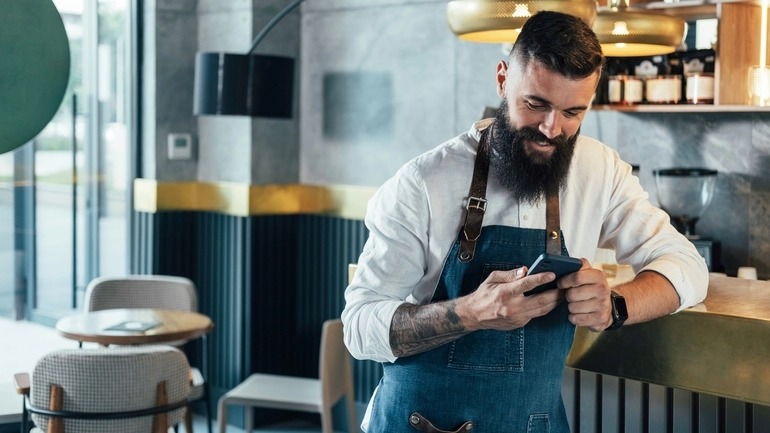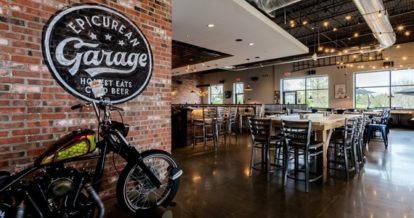The pop song “Call Me Maybe” might have been a one-hit-wonder, but restaurant phone systems are here to stay. Taking phone calls is an important part of your restaurant’s business – even in the digital era.
Investing in a reliable, easy-to-use phone system is a smart move for several reasons. For one, being available to answer questions by phone is a great way to build trust with potential customers. Not to mention, systems with automation capabilities can also reduce the time your employees spend on the line, while increasing the volume of your business.
Whether you’re considering upgrading your restaurant phone system or wondering if you even need one, this guide has all the answers. We’ll cover four different systems and the benefits of using a phone system for restaurants. You’ll want to stay dialed in for this one!
4 Different Types of Restaurant Phone Systems
You need a restaurant phone system that can keep up with your business. Considering that businesses miss 22% of the calls they receive (and up to 62% when it comes to small businesses), having a subpar phone system can cost you cold, hard cash. Now, let’s explore a few options so you can decide on the best restaurant phone system for your venue.
Key Service Unit (KSU) Telephones
A KSU telephone is a basic multi-line phone system for restaurants or other businesses. It’s an ideal option for teams of fewer than 50 employees.
KSU systems are easy to use and budget-friendly, making them one of the best phones for restaurants. No advanced technical training required here! With a KSU system, you’ll get features like speakerphone, paging, intercoms, and hold lines. Just be sure not to lean too heavily on the hold feature, since 60% of customers will hang up after just one minute (and 41% of callers aged 18 to 24 won’t wait at all).
If you’re considering a KSU system, it’ll have to be installed by a professional and hardwired into your restaurant. You’ll get between 5 and 40 different phone lines depending on your needs, all connected to the hardwired unit. You’ll also have to sign up for a service and maintenance plan if you choose this option.
Non-KSU Telephones
Does a KSU system sound like more than what you need to field the occasional call from a customer? A non-KSU telephone could be the perfect option for your restaurant. This phone system is exactly like your landline at home.
If you need fewer than 5 phone lines, a non-KSU system will work for you. This kind of phone is simple to use, less costly than its KSU counterpart and you can even install it yourself (wave goodbye to that set-up bill!).
Restaurateurs on a tight budget should keep in mind that even a non-KSU system can be more expensive than your home phone. This is because telephone companies may charge more for business lines. Overall, this option won’t break the bank, though.
Private Branch Exchange (PBX) Systems
While KSU and non-KSU phones might work for restaurants with one location, a PBX system is the best restaurant phone system for multiple locations that need to transfer calls from one venue to another.
If your restaurant needs a custom designed phone system with advanced functionality, including privacy features, the PBX system is your best bet. Unlike KSU phones, which can only redirect calls to a central hub, PBX phones let you switch hubs while you’re on a call. The PBX system can handle more than 40 phone lines (more than KSU phones), which also makes it a great option for multi-location restaurants.
Some PBX systems even offer instant messaging and video chat capabilities. This is a huge perk, considering that 53% of consumers prefer to receive customer service via messaging, and 93% trust messaging as a communication channel.
When it comes to installation and servicing, PBX phones require a professional, just like KSU systems (no do-it-yourself attempts, please!). While PBX phones are more expensive, you may be able to save on the upfront costs if you can get a financing plan for the hardware, so be sure to ask your provider. Once your system is up and running, you’ll be able to manage a high volume of calls with ease. Did someone say Hotline Bling?
Voice over Internet Protocol (VoIP) Systems
If PBX is the Mercedes-Benz of phone systems, VoIP is the Tesla. Think digital-first: this system operates on your internet connection rather than a traditional phone line. The catch? It’s a good phone system for restaurants with reliable internet service, but probably a poor choice for those with spotty coverage.
There are two main kinds of VoIP systems you can choose from. With an on-premises system, your phone provider will install equipment inside your restaurant to route calls over your internet network. Another option is a cloud system, which doesn’t require hardware and carries lower installation and maintenance costs. The only downside to the cloud system is that you won’t have control over when upgrades happen, and your monthly costs could increase over time.
With the worldwide VoIP market valued at over $30 billion in 2020 and expected to triple by 2027, this tech is more than just a passing fad. It could be the next best thing for your restaurant.

Benefits of Using a Restaurant Phone System
We’ve covered four of the best phones for restaurants. Now, let’s walk through the benefits of using a restaurant phone system.
1. Enhance the Customer Experience
As a seasoned restaurateur, you know your food needs to be delicious – not to mention Instagram-worthy – to keep your customers coming back for more. But there’s another important ingredient in the recipe for success: top-notch restaurant customer service.
Your phone system plays a key role in your overall customer experience, even in today’s digital world. In fact, 41% of U.S. and U.K. consumers still prefer the phone for customer service according to a 2021 statistic.
Imagine this scenario, for instance: one of your regular guests tries to call you to make a reservation for a party of 10 on Saturday evening. They get a busy signal on the first, second, and third dial. After three tries, they decide to call another restaurant, dine there on Saturday night instead, and end up becoming return customers at that other restaurant. This is a direct hit to your bottom line.
With a multi-line phone system, you won’t have to worry about missing a customer’s call if you’re on the other line. And with a system that’s connected to your mobile phone, you’ll be able to answer every call, even if you’re not at the restaurant.
For more robust operations (a restaurant with a brewery on-site, for example), phone system auto-attendants can ensure callers are directed to the right person with ease. And if you really want to get fancy with this technology, you can even implement a callback system as opposed to having customers wait on the line, which 63% of consumers surveyed prefer.
Most importantly, being able to reach you on the phone helps build trust with your customers. It’s a direct line of communication that feels personal – and that goes a long way in building relationships with your guests.
2. Increase Productivity
It’s no secret that restaurant technology can free up your front-of-house team’s valuable time. In a world where time equals money, issues that might seem small, like multitasking, can actually decrease your staff’s productivity by as much as 40%. This is why it’s worth your while to eliminate distractions such as spam calls, which phone systems can help filter out.
In addition, adding a mobile extension to your restaurant phone system can make it easier for managers to take calls on the go – especially if you have multiple locations that they’re traveling between. This will ensure your key team members can be reached by phone, but also get other work done without having to stay put in one place.
Modern tech like restaurant phone systems can even make taking orders and reservations easier. This is a win-win, because the more orders and reservations you can accept, the more sales you can make.
3. Boost Revenue
Your passion for cooking may be the inspiration behind your restaurant, but your business acumen is just as important when it comes to keeping your doors open in the long term. That includes being able to increase your revenue year-over-year as your operational costs rise. One surefire way to do this is by making it easy for people to spend money at your restaurant.
Implementing a restaurant phone system (or upgrading your existing system) might not seem like a money-making strategy on the surface, but it can be an excellent way to give your revenue a boost. A phone system offers guests more ways to reach you beyond digital channels, so they can place orders, book tables, and more in the way that’s most comfortable for them. And what’s good for your guests is good for your business!
You’re now familiar with four different types of restaurant phone systems, plus the benefits of having a modern phone system at your restaurant. Ready, set, hello!
Get the Complete Guide to Restaurant Reservations
Sign up for our free weekly TouchBistro Newsletter







